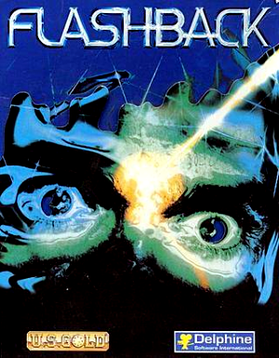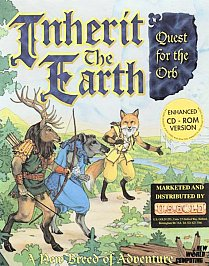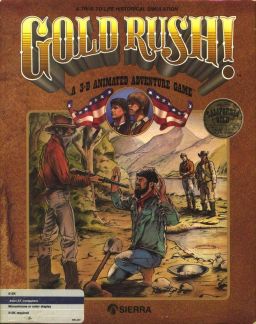
Simon the Sorcerer is a 1993 point-and-click adventure game developed and published by Adventure Soft, for Amiga and MS-DOS. The game's story focuses on a boy named Simon who is transported into a parallel universe of magic and monsters, where he embarks on a mission to become a wizard and rescue another from an evil sorcerer. The game's setting was inspired by the novels of the Discworld series, and incorporates parodies on fantasy novels and fairy tales, such as The Lord of the Rings and Jack and the Beanstalk. The lead character's design was inspired by that of the fictional British television character Blackadder, with the character voiced by Chris Barrie in the CD re-release.
Wizardry is a series of role-playing video games, developed by Sir-Tech, that were highly influential in the evolution of modern role-playing video games. The original Wizardry was a significant influence on early console role-playing games such as Final Fantasy and Dragon Quest. Originally made for the Apple II, the games were later ported to other platforms. The last game in the original series by Sir-Tech was Wizardry 8, released in 2001. There have since been various spin-off titles developed for the Japanese market.

Script Creation Utility for Maniac Mansion Virtual Machine (ScummVM) is a set of game engine recreations. Originally designed to play LucasArts adventure games that use the SCUMM system, it also supports a variety of non-SCUMM games by companies like Revolution Software and Adventure Soft. It was originally written by Ludvig Strigeus. ScummVM is free software that is released under the terms of the GNU General Public License.

Dizzy is a series of video games, created by the Oliver Twins and published by Codemasters. It was one of the most successful British video game franchises of the late 1980s and early 1990s. Originally created for the ZX Spectrum and Amstrad CPC, the series appeared on multiple home computer and video game console formats, with over a dozen games being published between 1987 and 1992.

Christopher Hülsbeck, known internationally as Chris Huelsbeck, is a German video game music composer. He gained popularity for his work on game soundtracks for The Great Giana Sisters and the Turrican series.

Flashback, released as Flashback: The Quest for Identity in the United States, is a 1992 science fiction cinematic platform game developed by Delphine Software of France and published by U.S. Gold in the United States and Europe, and Sunsoft in Japan.

Inherit the Earth: Quest for the Orb is an adventure game developed by The Dreamers Guild and published by New World Computing in 1994.

The Faery Tale Adventure is a 1987 action role-playing video game designed by David Joiner and published by MicroIllusions for the Amiga, and later ported to the Commodore 64, MS-DOS, and Sega Genesis. The MS-DOS version is titled The Faery Tale Adventure: Book I. Microillusions also released a "Book 1" version for the Amiga which was going to be the start of a series of games, according to Talin, but bankruptcy prevented it. The initial version was produced for the Amiga 1000 and featured the largest game world to that date. A sequel, Faery Tale Adventure II: Halls of the Dead, was released in 1997.

The Labyrinth of Time is a graphic adventure video game created by Terra Nova Development, a two-man team composed of Bradley W. Schenck and Michal Todorovic. Intended to be the first in a series of games, The Labyrinth of Time was less successful than similar graphic adventures released around the same time, such as The 7th Guest and Myst. It is the sole game produced by Terra Nova Development. In the years after its release, The Labyrinth of Time was published on more recent platforms by The Wyrmkeep Entertainment Co. in collaboration with the original developers.

Gold Rush! is a graphic adventure video game designed by Doug and Ken MacNeill and originally released by Sierra On-Line in 1988.

I Have No Mouth, and I Must Scream is a 1995 point-and-click adventure horror game developed by Cyberdreams and The Dreamers Guild, co-designed by Harlan Ellison, published by Cyberdreams and distributed by MGM Interactive. The game is based on Ellison's short story of the same title. It takes place in a dystopian world where a mastermind artificial intelligence named "AM" has destroyed all of humanity except for five people, whom he has been keeping alive and torturing for the past 109 years by constructing metaphorical adventures based on each character's fatal flaws. The player interacts with the game by making decisions through ethical dilemmas that deal with issues such as insanity, rape, paranoia, and genocide.

Quest for Glory: So You Want to Be a Hero is a 1989 adventure game/role-playing game hybrid, designed by Lori Ann Cole and published by Sierra On-Line for MS-DOS. It is the first game in the Quest for Glory series, and has been credited for being a genre-defining game, as it tried to mix graphical adventure gaming with role-playing-like elements such as statistic building that would actually affect the ability to accomplish certain parts of the game. The game has a satirical and silly tone. Ports for the Amiga, Atari ST, and NEC PC-9801 were released in the early 1990s. A VGA remake, titled Quest for Glory I: So You Want to Be a Hero, was released in 1992 for DOS and later in 1994 for Mac OS.
MicroIllusions, based in Granada Hills, California was a computer game developer and publisher of the home computer era. MicroIllusions, as a company, was a strong supporter of the Amiga and typically released titles on that platform before porting it to others. Activision cancelled them as an affiliated publisher after a year of signing them up. The company went out of business in or about 1990.

Toki is a run and gun platform game released in arcades in Japan in 1989 by TAD Corporation. It was published in North America by Fabtek. Designed by Akira Sakuma, the game has tongue-in-cheek humor mixed with the action. The player controls an enchanted ape who must battle hordes of jungle monsters with energy balls from his mouth. The ultimate goal is to destroy the evil wizard who cast a spell on the title protagonist; thereby transforming him from an ape back into a human, and rescuing the kidnapped princess. The game was ported to several video game consoles and home computers.
Bradley W. Schenck is an American artist and game designer.

Steve Fawkner is an Australian video game designer, programmer, and composer. He created the Warlords game series, first released in 1989, and the Puzzle Quest series which began in 2007. He has been regarded as one of the worlds most prolific and talented game designers.

Transylvania is an adventure video game published by Penguin Software. It was released for the Apple II in 1982 followed by ports to the Atari 8-bit family and Commodore 64. A Macintosh conversion was published in 1984, then versions for the Amiga, Atari ST, and MS-DOS in 1985.

The Legend of Kyrandia: Book One is a 2D point-and-click adventure game, developed by Westwood Studios and published by Virgin Games in August 1992. The game is the first in the The Legend of Kyrandia series, and focuses on players taking on the role of a young prince who put an end to the tyrannical chaos of an evil court jester.

Faery Tale Adventure II: Halls of the Dead is a video game developed by American studio The Dreamers Guild and published by Encore Software in 1997 for MS-DOS and Microsoft Windows. It is the sequel to the 1987 game The Faery Tale Adventure. It was the last game developed by The Dreamers Guild before the studio's closure.
















